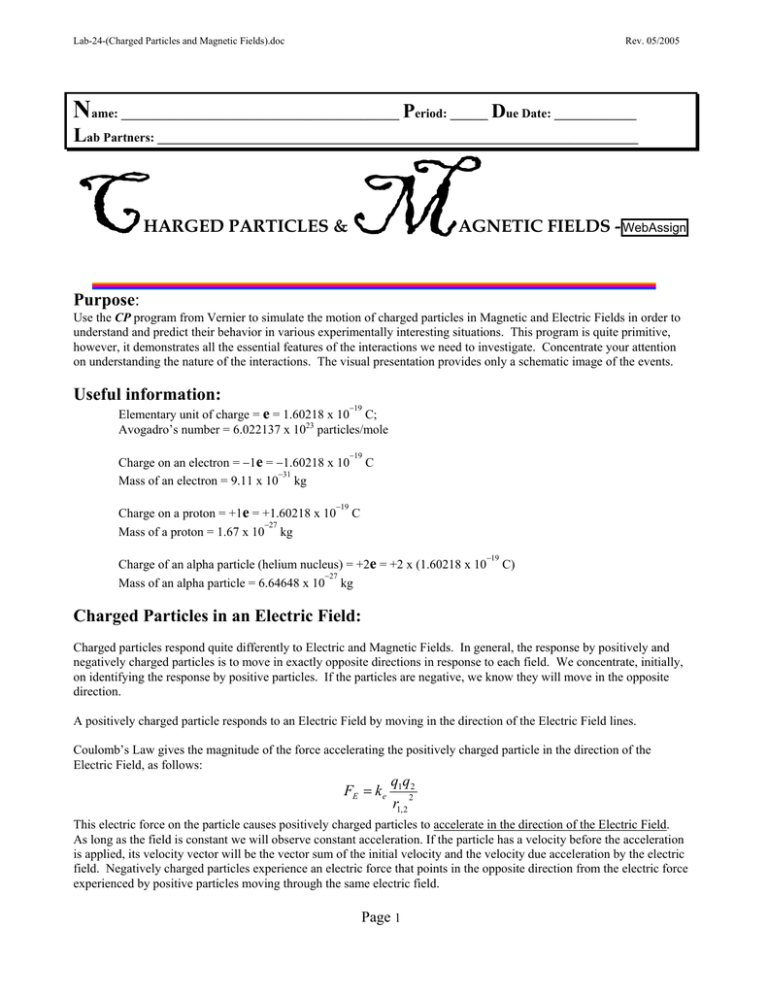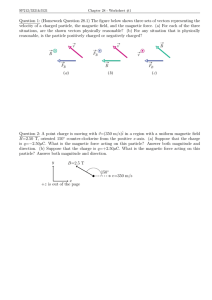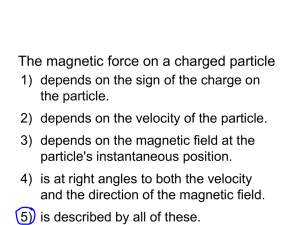Lab-24-(Charged Particles and Magnetic Fields).doc
advertisement

Lab-24-(Charged Particles and Magnetic Fields).doc Rev. 05/2005 Name: ____________________________________________ Period: ______ Due Date: _____________ Lab Partners: ____________________________________________________________________________ C M HARGED PARTICLES & AGNETIC FIELDS - WebAssign Purpose: Use the CP program from Vernier to simulate the motion of charged particles in Magnetic and Electric Fields in order to understand and predict their behavior in various experimentally interesting situations. This program is quite primitive, however, it demonstrates all the essential features of the interactions we need to investigate. Concentrate your attention on understanding the nature of the interactions. The visual presentation provides only a schematic image of the events. Useful information: −19 Elementary unit of charge = e = 1.60218 x 10 C; Avogadro’s number = 6.022137 x 1023 particles/mole Charge on an electron = −1e = −1.60218 x 10 −31 Mass of an electron = 9.11 x 10 kg Charge on a proton = +1e = +1.60218 x 10 −27 Mass of a proton = 1.67 x 10 kg −19 −19 C C Charge of an alpha particle (helium nucleus) = +2e = +2 x (1.60218 x 10 −27 Mass of an alpha particle = 6.64648 x 10 kg −19 C) Charged Particles in an Electric Field: Charged particles respond quite differently to Electric and Magnetic Fields. In general, the response by positively and negatively charged particles is to move in exactly opposite directions in response to each field. We concentrate, initially, on identifying the response by positive particles. If the particles are negative, we know they will move in the opposite direction. A positively charged particle responds to an Electric Field by moving in the direction of the Electric Field lines. Coulomb’s Law gives the magnitude of the force accelerating the positively charged particle in the direction of the Electric Field, as follows: FE = k e q1q2 2 r1, 2 This electric force on the particle causes positively charged particles to accelerate in the direction of the Electric Field. As long as the field is constant we will observe constant acceleration. If the particle has a velocity before the acceleration is applied, its velocity vector will be the vector sum of the initial velocity and the velocity due acceleration by the electric field. Negatively charged particles experience an electric force that points in the opposite direction from the electric force experienced by positive particles moving through the same electric field. Page 1 Lab-24-(Charged Particles and Magnetic Fields).doc Rev. 05/2005 Charged Particles in a Magnetic Field: A positively charged particle will only respond to a constant Magnetic Field if the particle is moving through the field with a velocity component perpendicular to the direction of the Magnetic Field. A stationary charged particle will not respond to a constant Magnetic Field. Furthermore, a particle moving parallel to the Magnetic Field lines will not experience the Magnetic Force, either. Recall the Physicist’s Salute. If the velocity and the Magnetic Field lines are in the same direction, the right-hand-rule will not define a unique direction for the force (i.e. there will be no magnetic force). A positively charged particle will respond to a Magnetic Field with a force proportional to the component of the Magnetic Field perpendicular to the velocity vector. The direction of the force on the particle is given by the right-hand-rule. The direction of the magnetic force is perpendicular to both the direction of the magnetic field and the direction in which the particle is moving. The magnitude of the magnetic force is given by the following equation. FB = qvB⊥ = mv 2 r Where v is the velocity of the particle, B ┴ is the component of the magnetic field perpendicular to the velocity vector, q is the electric charge on the particle, m is the mass of the particle, and r is the radius of the circle through which the particle is turned by the interaction with the magnetic field. The direction of the magnetic force is perpendicular to both the v and B vectors. Because it is perpendicular to v, the magnetic force will cause the particle to move around a circle or circular arc at constant velocity, as long as the magnetic field remains constant. Since the magnetic force always acts perpendicular to the velocity vector, it changes neither the magnitude of the velocity vector nor the kinetic energy of the particle. It can only change the direction of the velocity vector. Also, since the magnetic force always acts perpendicular to the velocity vector, it acts as a centripetal force to move the particle through a circular arc. If the Magnetic Field is constant and uniform over a volume, this can cause the particle to move through a full semi-circle when it enters that volume from the outside the Magnetic Field. If the particle is initially inside the Magnetic Field, the Magnetic Field can cause the particle to move through a complete circle. The Challenges: The challenges listed in the following sections appear on the main menu of the CP program. Select the appropriate letter to begin each challenge. The CP program is keyboard oriented. Your mouse does not work. Watch the menu at the bottom of each screen for keys to use. Check the panel in the upper-right-hand corner where the directions of the Electric and Magnetic Fields are shown whenever these fields have non-zero values. You can increase the Electric and Magnetic Fields using the E and B keys. To decrease the Electric and Magnetic Fields, or even make them negative, use the [ctrl]-E and [ctrl]-B key combinations. (Hold the [ctrl] key down while pressing the E or B key.) Electric and Magnetic Fields may be positive or negative. The only difference between positive and negative is the direction the field points. One habit you will need to develop is typing the ENTER key to start a run or switch screens. Play with the keys until you get the hang of it. There are only a few housekeeping chores. One chore that you will need to use frequently is clearing the screen. Clear the screen, using the C key, before making any critical test runs. Page 2 Lab-24-(Charged Particles and Magnetic Fields).doc Rev. 05/2005 1. Do Challenge 1. You must first calculate the Magnetic Field needed to make an electron move in a semicircle with a diameter near 10 cm; then verify your result with CP. Make sure the electron (it has a negative charge) moves to the right, not to the left. Otherwise, you will not be able to see that the diameter is correct. The magnetic force, FB, acts as a centripetal force, therefore, mv 2 F B = qvB = r , therefore, solving for B yields; B = _________________________ (Show the equation in the space above) Note the mass and velocity of the electron: m = __________________ kg; v = __________________ m/s Note the charge and target radius of the circle: q = __________________ C; r = __________________ m Calculate the Magnetic Field (B) needed. B = ________________ T (This requires you to use your calculator) Note the observed Magnetic Field and radius: Bobs = ________________ T; robs = __________________ m Remember that the direction predicted by the right hand rule applies to positive charges, and that negative charges move in the opposite direction when they interact with a Magnetic Field. What happens to the speed of the particle as it moves in a circular arc? [Increases, Decreases, No change] (circle one) (Divide half the circumference of the circle by the time the particle takes to traverse that distance. Then compare the calculated average velocity to the initial velocity chosen by the program.) What effect does the Magnetic Field have on the kinetic energy? [Increases, Decreases, No change] (circle one) Page 3 Lab-24-(Charged Particles and Magnetic Fields).doc Rev. 05/2005 2. Do Challenge 2. You must calculate the Magnetic Field required to move an alpha particle through a circular arc with a radius near 5 cm. Make sure the alpha particle moves to the right, not to the left. Otherwise, you won’t be able to read the actual diameter to verify the radius. Note the mass and velocity of the alpha particle: m = __________________ kg; v = __________________ m/s Note the charge and target radius of the circle: q = __________________ C; r = __________________ m Calculate the Magnetic Field needed. B = ________________ T (This requires you to use your calculator) Note the observed Magnetic Field and radius Bobs = ________________ T; robs = __________________ m Remember that the direction predicted by the right hand rule applies to positive charges. Verify the result by making the alpha particle move in a circle. Select the closest available Magnetic Field setting. What happens to the speed of the particle while it moves in a circle? [Increases, Decreases, No change] (circle one) (Divide half the circumference of the circle by the time the particle takes to traverse that distance. Then compare the calculated velocity to the initial velocity chosen by the program.) What effect does the Magnetic Field have on the kinetic energy? [Increases, Decreases, No change] (circle one) Page 4 Lab-24-(Charged Particles and Magnetic Fields).doc Rev. 05/2005 3. Do Challenge 3. You must determine the q/m ratio for an unknown particle. Then attempt to identify it. Make the Magnetic Field point out of the page •. The particle's path bends to the [right / left]. Think about the physics salute (AKA the right-hand rule). The charge on the particle is [positive / negative]. With so little information, you will not be able to solve for charge or mass, but you will be able to solve for charge divided by mass, i.e., the charge-to-mass ratio. Rearrange the equation (Force of the Magnetic Field on a moving particle = centripetal force) qvB = mv 2 q q , therefore, solving for yields, = r m m _____________________ (Show the equation in the space above) Adjust the Magnetic Field until the particle makes a semicircle. Use the field, velocity and radius to calculate q/ m. (Note: Do not rely on the sign of B to determine the sign of q. Use the right-hand rule to find the sign of q.) Note the values: v = ___________________ m/s; r = _____________________ m; B = ________________ T q / m (unknown particle) = _____________ C/kg (Note: q and m are constants for each particle.) What might the particle be? First, calculate the q/ m ratios for three known particles from the data on page 1. q / m (for an electron) = _____________ C/kg q / m (for a proton) = _____________ C/kg q / m (for an alpha particle) = _____________ C/kg What is the unknown particle? ___________________________ Page 5 Lab-24-(Charged Particles and Magnetic Fields).doc Rev. 05/2005 4. Do Challenge 7 (Velocity Filter). Both Electric Fields and Magnetic Fields exert forces on charged particles. If these forces happen to be equal and opposite, the particle will move in a straight line. The two forces can be equal and opposite for only one specific velocity at a time, however. To solve for that velocity we observe the following, FB = FE If qvB = qE Then Therefore v=E/B Find a combination of E (Electric Field) and B (Magnetic Field) that allows the particle to move in a straight line through the Velocity Filter. There are many different possibilities, but their ratio can have only one value. Try using the B value set by the program. Adjust E until the particle moves straight up. Report your E and B values. (Note: zero is not an acceptable answer for either field value.) Note the of the particle velocity chosen by the program: v = ___________________ m/s E = ______________________N/C, B = _______________________ T, Therefore, the predicted velocity of particles that move straight up is v = E/ B = ______________________ m/s Researchers use this method to determine the speed of a charged particle or to select particles with a specific speed from a collection of particles moving at many different speeds. It is a very handy device when working with charged particles in devices ranging from television sets to high-energy particle accelerators. Note that the name, Velocity Filter or Velocity Selector, should make it clear that this device does not change the velocity of the particles that enter it. All it does is select the particles with a specific velocity by allowing them to pass straight through, while particles with higher and lower velocities are eliminated. Page 6 Lab-24-(Charged Particles and Magnetic Fields).doc Rev. 05/2005 5. Do Challenge 8. In this challenge you will be working with an unknown element, Z. The charge on the unknown ion is q = +1.6E(-19) C (even though the Introduction to Challenge 8 says it has a negative charge; verify this for yourself using the right-hand rule). Try sending the ions through the Magnetic Field as set up at the beginning of the challenge (B = -0.7 N/amp-m and v = 1.00 E5 m/s). Repeat this several times without changing the fields or the speed. There will be more than one path because chemically pure samples of element Z ions contain more than one isotope of element Z. How many isotopes did you detect? _________________ (More than one but less than five) Note the radius of each isotope’s circle: __________________ m; ___________________ m; _________________ m Calculate the q/ m ratio of each isotope: _________________C/kg; _________________C/kg; _______________C/kg Calculate the mass of each isotope of Z: __________________ kg; __________________ kg; _________________ kg Convert mass to atomic mass units (u): ____________________ u; ____________________ u; __________________ u −27 (1 u = 1.66054 x 10 kg) Run it many times and find the isotope abundances: _______________ %; _______________ %; _______________ % (Run 100 and count the number of each isotope) Use the isotopic abundances to calculate the apparent atomic weight: __________________ u or gm/mole [AW (in u or gm/mole) = fraction1 x mass1 + fraction2 x mass2 + …] Use a periodic table to determine the element. ______________ (which has an atomic weight = _______________ u) This device is called a mass spectrometer and is used to identify the mass of ions derived from the breakup of chemical compounds that have been ionized inside the device. Most mass spectrometers produce negative ions, though this one appears to be making positive ions. Page 7 Lab-24-(Charged Particles and Magnetic Fields).doc Rev. 05/2005 Sample Calculations: Page 8 Lab-24-(Charged Particles and Magnetic Fields).doc Rev. 05/2005 Now on WebAssign – Included here for practice only. Problems for Analysis: (Do these problems on a separate sheet) 1. What is the mass of an ion with a +1e charge moving at 2.2 E5 m/sec in a circle with a radius of 0.25 m in a Magnetic Field of 0.06 T ⊗? ( e is the elementary unit of charge.) 2. What is the charge on a magnesium ion with a mass of 3.99E-26 kg moving counterclockwise in a circle with a radius of 0.25 m at 2.2 E5 m/sec in a Magnetic Field of 0.110 T ⊗? 3. What is the kinetic energy of a proton making a circle 3.0 meters in diameter in a Magnetic Field of 5.6E−4 T? 4. What is the period of revolution of an electron making complete circles at 4.5 E6 m/sec in a Magnetic Field of 0.44 T? 5. A proton is moving at 95% the speed of light in a particle accelerator. It is moving in a circle with a diameter of 1.60 kilometers (1 mile). Find the strength of the Magnetic Field, B, needed to keep this proton moving in a circle. The speed of light is c = 3.00E8 m/sec. Note: the mass of a particle increases with its speed according to the equation, mv = m0 1− v2 c2 where m0 is the rest mass, the particle’s mass when it’s not moving, and m v is its mass when its moving at velocity v. Page 9




